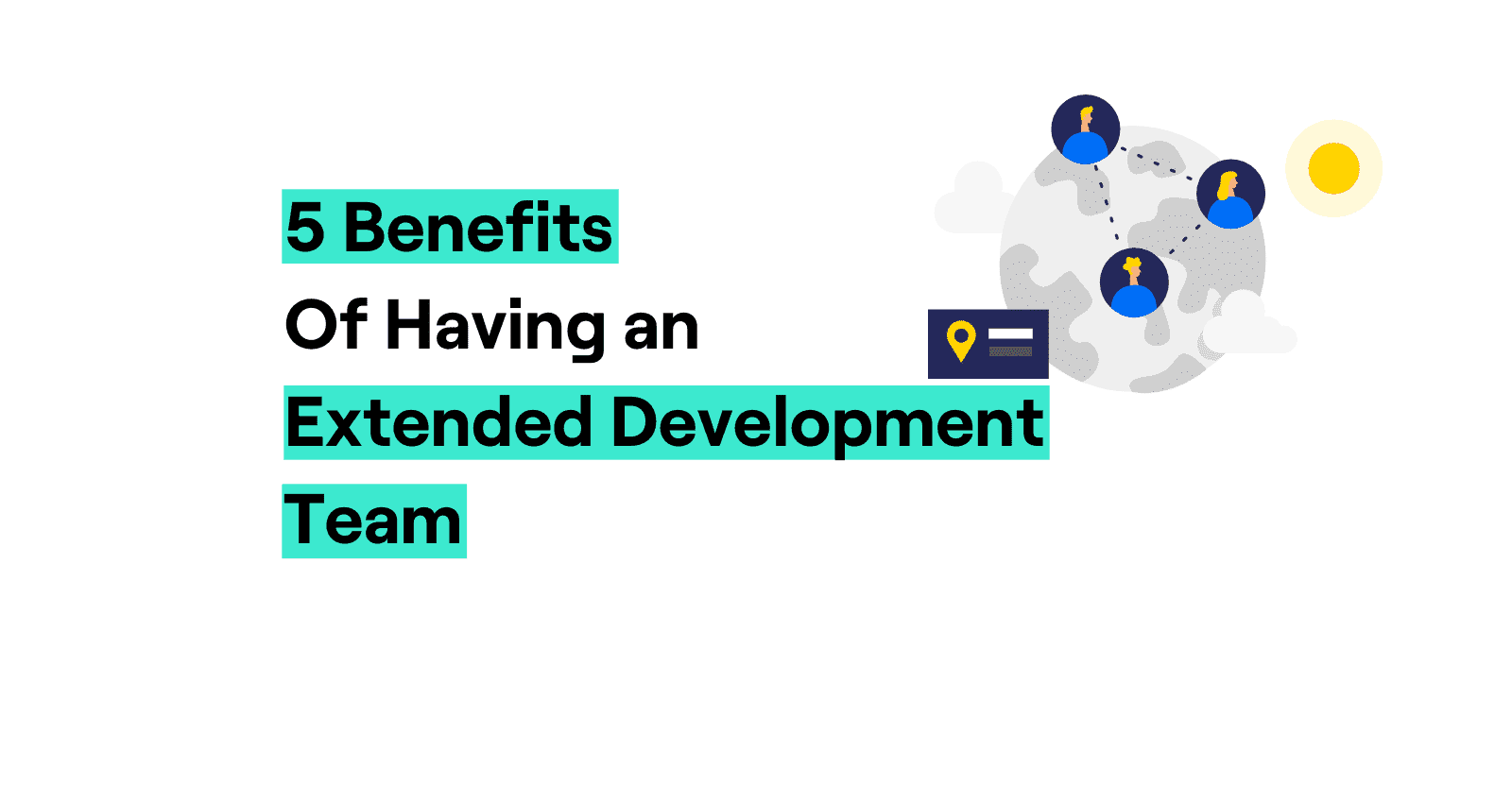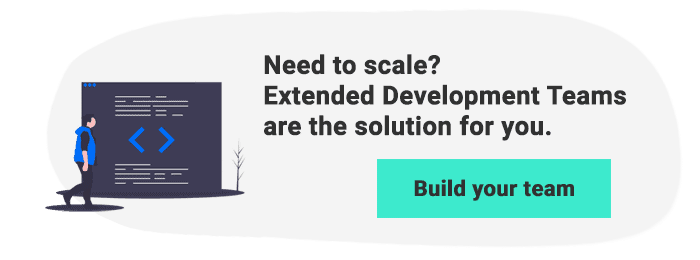You probably have an excellent in-house team of engineers already — so why should you care about the benefits of having an extended development team?
Here’s the thing: investing in a remote software team is probably the easiest way to fill in skill gaps in your core staff, build lasting partnerships with brilliant developers, and get long-term projects done quickly and effectively.
The best part?
It all comes at a fraction of the cost of hiring full-time employees.
But we are getting ahead of ourselves.
First things first:
What Is an Extended Development Team Model?
The extended team model, also known as staff augmentation, brings together in-house and remote or “extended” engineers and has them working on the same projects. This long-term cooperation model cuts costs while benefiting from the skills of additional top calibre developers.
For optimal cost-effectiveness, extended software teams are often “nearshored” to a neighboring country — or even “offshored” to a whole different continent.
Extended Development Teams vs. Traditional Outsourcing
By now, you are probably thinking, Why should I choose an extended development team over traditional outsourcing?
And you’ve got a point there: the extended team model does share some benefits with traditional outsourcing. For instance, both models allow you to tap into a larger talent pool and offer quick and efficient team scalability.
However, there’s one key difference — and that makes all the difference, if you’ll pardon the pun.
In traditional outsourcing, you hand over the entire development process to an outside team. As budget-friendly as that may be, it often goes hand-in-hand with a certain lack of transparency and limited managerial oversight over the code you’re getting.
In contrast, one of the benefits of having an extended development team is that your in-house and remote engineers work closely together. Because they have common goals and responsibilities, they build an ongoing partnership and learn from one another — and you always know exactly what’s going on. That is why it is called ‘nearshoring‘.
Don’t get us wrong, though: full project outsourcing can work great for short-term or one-off assignments. It’s just not the best solution for when you are looking to establish lasting cooperation or to work on more complex projects. Check out this more in-depth blog on the best country to outsource software development – based on your specific needs.
The Benefits of Having an Extended Development Team
1. You Save Time on Hiring While Staying in Control
Does the thought of going through the drudgery of recruitment, training, and onboarding full-time engineers fill you up with joy?
Didn’t think so.
Lucky for you, extended development teams offer a quicker and more streamlined alternative. You get to assemble your dedicated development team and have it up and running in no time.
What’s more, because all project management takes place in-house, you are always on top of the product development.
At Zartis, we design a custom recruitment process that evaluates candidates in-depth and for the precise skills you need. We also take care of the sourcing, testing, and interviewing of applicants. You only see the ones we handpick for you and get to choose from the top of the top. This way, you are always in control over who works on your code.
If that sounds like something you could use, call us up.
2. Cost-Effectiveness
Nothing beats a good bargain.
One of the key advantages of extended software teams is that they are budget-friendly.
US companies with extended teams in Europe can expect to cut their costs by up to 40%. And our Irish and UK-based clients that set up a software team extension in Spain or Poland can save anywhere from 15 to 25%.
What’s even better is that the lower cost does not come at the expense of quality. You can have your pick from an international pool of top-level engineers that have been thoroughly vetted and come with a proven track record of delivering excellent results.
3. Increased Transparency, Trust, and Collaboration
Direct communication, transparency, and trust are an integral part of any successful long-term collaboration — and that’s exactly what you get with staff augmentation.
Because extended development teams work closely with your core stuff, you can benefit from:
- Ongoing and effective communication
- Total transparency around the work being done
- Shared responsibility on the deliverables
- Increased productivity
Furthermore, the two teams complement their skills and exchange knowledge, ideas, and problem-solving techniques.
The result?
Not only do you gain a new set of brilliant remote engineers, but your existing employees also get to learn new things and become better professionals.
And that’s not a rare occurrence, either. At Zartis, we constantly see our engineers working on improving the client company. They provide expert advice and organize various trainings on topics ranging from architecture and DevOps to process improvements and more.
4. No Setup or Operational Hassle
Compared to standard recruitment, the extended development team model requires little to no operational hassle.
With most of the work being done remotely, you don’t have to worry about:
- Payroll and employee benefits
- Buying equipment
- Setting up physical workstations
- Renting and maintaining an office space
- Enabling a home-office setup
- Looking after tech support
What’s more, you don’t have to do all that in a location and jurisdiction you are not familiar with. At Zartis, we take care of all that, so you can focus on what you do best — building great software.
The only thing you need to do is assemble the remote team and ensure they have access to the software and information systems they will need to do their work.
5. Faster Time to Market
In addition to saving a substantial amount of time on recruitment and setup, you also get to speed things up by having additional resources work on the same software development project simultaneously. By sharing and distributing tasks among themselves, your engineers will get more work done in less time.
But that’s not all.
One of the major benefits of having an extended development team is that your remote engineers will not be juggling a handful of different projects, which is often the case with outsourcing. As a result, the team will be dedicated to and fully invested in your project — and will get things done quickly and efficiently.
Tips on How to Get Staff Augmentation Right
-
Choose a Partner You Trust
You don’t need us telling you that getting the right developers on your team is critical. Products don’t make themselves, and even the most foolproof software development model cannot make up for poor hiring choices.
It’s essential to find a partner you trust to get you the right developers, make sure all is running smoothly and have your back. And the best way to evaluate a potential partner? Talk to them.
We at Zartis know the ins and outs of the industry and have a proven track record of setting up extended software teams.
To learn more about our services and how we can help you integrate the extended team model into your business, contact us today — we’d love to have a chat.
-
Build a Relationship and Set Up Proper Onboarding
Just because your new engineers are remote doesn’t mean they are any less human.
As with any new employee or business partner, you want to establish trust and a genuine connection early on. In practical terms, that means providing your extended team members with comprehensive onboarding into your systems, documentation, internal processes, etc. And while you’re at it, make sure to introduce them to all your in-house engineers.
Remember: staff augmentation is about long-term collaboration. If you are not going to take the long view, you might as well outsource. Even if you never get the chance to meet your remote software team face-to-face, make an effort to integrate them into the existing team. It will more than pay off further down the line.
-
Set Clear Requirements, Goals, and KPIs
For all the benefits of having an extended development team, remote work also has its challenges.
One of the bigger ones is that communication can get watered down, which could have serious consequences for your return on investment.
To avoid that, you need to get your in-house team and the extended developers on the same page. Get crystal clear on your requirements and goals. Also, make sure that the members of your extended team understand their tasks and the specific KPIs you will be using to evaluate their performance.
Clear KPIs, in particular, have been linked to higher job satisfaction and work engagement, so getting that right will ensure a productive relationship with your extended team.
-
Know When to Use the Extended Team Model — and When Not To
Extended development teams work great in many organizational contexts. However, that doesn’t necessarily mean this model would be a good match for you.
Knowing when to use staff augmentation and when to stick to outsourcing or in-house development is vital to the success of your projects.
As a rule of thumb, the extended team model is an excellent choice for long-term collaborations and for when you want to add new skill sets to those of your core developer team.
And if your project is still at an early stage and you don’t even have in-house engineers, extended development teams can help you minimize costs while staying on top of the product development.
However, if you are only looking to do a one-off project, you might want to consider traditional project-based outsourcing instead.
Final Thoughts
At Zartis, we can help you build an extended development team from scratch. We will offer you a personalized and cost-effective solution that:
- Minimizes risks
- Meets your unique goals and development needs
- Cuts down on the admin and the red tape
But most importantly, we will handpick the best engineers who will get the job done.
Interested? Drop us a line. We will book you in for a consultation right away.
Want to Learn More About the Benefits of Having an Extended Development Team?
For more expert tips on how to do staff augmentation right, check out our 3 Easy Steps for Setting Up an Extended Development Team, where we cover nearshore solution design, deployment, set up, ongoing management — and more.
Follow that up with our post on Widening the Nearshore Definition: Accessing Engineers in Europe, and finish things off with this Interview with a Coder: Killer Insights for Distributed Teams.
And if you are based in the UK, make sure to read our case study of Nearshore Teams for UK Companies in Madrid!


